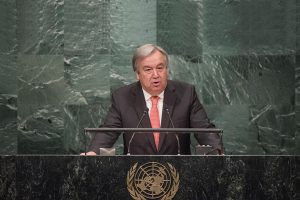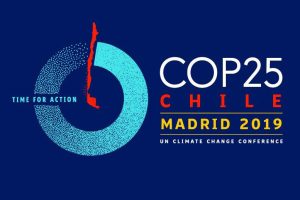From 24-25 October 2019, France will host the Green Climate Fund (GCF) Replenishment Pledging Conference in Paris, to cover the GCF’s programming from 2020 to the end of 2023. The conference will provide an opportunity for countries to allocate their international climate funding. It is taking place only months away from the 2020 start of developed countries’ collective pledge to jointly mobilize USD 100 billion of climate finance per year to address the needs of developing countries, and developed countries’ GCF funding support will count towards their collective USD 100 billion commitment.
Agreement on the USD 100 billion goal was reached following the 2009 Copenhagen Accord, in conjunction with the formal establishment of the GCF during the 2010 UN Climate Change Conference in Cancun, Mexico. Resources for the climate finance goal can come from a variety of sources: public and private, bilateral and multilateral, as well as alternative sources.
As an operating entity of the Financial Mechanism of the UNFCCC and the Paris Agreement, the GCF is a key multilateral funding source to support the flow of “adequate and predictable financial resources” towards investments in low-emission and climate-resilient development. Specifically, the GCF’s role is to channel climate finance from both the public and private sector to support projects, programs, policies and other activities in developing countries related to mitigation, including REDD+, and adaptation, capacity building and technology development and transfer. The GCF’s direct access modality allows national and sub-national organizations to receive funding directly, rather than only via international intermediaries, whereby the GCF’s investments can be in the form of grants, loans, equity or guarantees.
GCF Report to UNFCCC COP
The latest GCF report to the UNFCCC Conference of the Parties (COP) informs that the GCF Board approved USD 5.2 billion to support the implementation of 111 climate change adaptation and mitigation projects and programs in 99 developing countries. These projects and programs are expected to attract USD 13.5 billion in direct public and private sector co-financing. Of the 111 projects and programs approved, 70% involve least developed countries (LDCs), small island developing States (SIDS) and African states. It is expected that together these projects and programs will abate 1.5 billion metric tons of carbon dioxide equivalent (tCO2e). The total value of the projects and programs approved is USD 18.7 billion.
The main features of GCF funding activities from 1 August 2018 to 31 July 2019 include:
- In terms of regional distribution, the largest portion of GCF funding (42%) is allocated to the African region, followed by Asia-Pacific (32%), Latin America and the Caribbean (LAC) (22%) and Eastern Europe (5%).
- The private and public sectors, respectively, account for 41% and 59% of the GCF funding.
- In terms of project size, the category with the largest portion of GCF funding is large (44%), followed by medium (38%), small (15%) and micro (3%).
- In terms of financial instruments utilized, the largest portion of the portfolio is financed by grants (45%), followed by loans (42%), equity (9%), results-based payments (2%) and guarantees (2%).
- Energy access and power generation has the largest portion of GCF funding (40%), while low-emission transport accounts for the smallest (2%) among four mitigation results areas, which also include energy efficient buildings, cities and industries, and sustainable land use and forest management.
- Among the four adaptation results areas, ecosystems and ecosystem services had the lowest coverage (4%). The remaining 32% of GCF funding was almost equally distributed among the other three adaptation results areas: enhanced livelihoods of the most vulnerable people, communities and regions; increased health and well-being, and food and water security; and resilient infrastructure and built environment.
The report provides more specific updates, among others, on the Funds’ support for: forest-related actions; technology; and capacity building. It further informs, that during the GCF’s initial resource mobilization period (2015-2018), the Fund gathered USD 10.3 billion, as of 31 July 2019, coming mainly from developed countries, but also from some developing countries, regions, and the city of Paris.
GCF’s First Replenishment Engages Private Sector
In October 2018, the GCF Board decided to launch the process for its first formal replenishment with consultations held in 2019. In August 2019, the GCF convened a global programming conference under the title, ‘Realizing Climate Ambitions,’ in Songdo, Republic of Korea, at which many called for global support for the GCF’s first replenishment. Subsequently, during the G7 Summit, France announced its contribution of EUR 1.548 billion to the GCF’s replenishment. During the UN Secretary-General’s Climate Action Summit in September, a number of public and private sector actors pledged new financial contributions to the Fund, raising the GCF’s replenishment total beyond USD 7.4 billion.
Maximizing the engagement of the private sector is one of the GCF’s strategic plans. The Fund’s Private Sector Facility (PSF) was put in place to promote the participation of private sector actors in developing countries, consistent with a country-driven approach, in particular local actors, micro, small and medium-sized enterprises (MSMEs) and local financial intermediaries. The GCF’s recent report notes that, of the total USD 5.2 billion approved for all GCF projects, USD 2.2 billion, or 41%, came through the PSF in the form of 25 projects and programs. The private sector projects also include USD 7 billion in co-financing. The GCF Board has further established two pilots targeting the private sector: one to support MSMEs with an allocation of up to USD 200 million; and another to mobilize funds at scale in supporting the development of adaptation and mitigation projects with an allocation of USD 500 million. As part of the GCF’s private sector strategy, the PSF also supports private sector outreach.
The GCF’s second private sector conference titled, ‘Private Investment for Climate Conference,’ convened in Incheon, Republic of Korea, in October 2019, focusing on “how to break through market barriers which currently mean that only a small fraction of more than USD 210 trillion of private sector assets is funneled towards climate action.” Participants considered enhanced transparency as essential in identifying portfolio profiles and directing the flow of funding pipelines to meet climate financing needs. The conference also considered expanding the reach of climate bonds and drawing in debt and equity to drive a green transition.
Many stress that the GCF needs predictable resources – not only to support developing countries’ ability to strategize and plan their investments, including implementation of their Nationally Determined Contributions (NDCs) under the Paris Agreement on climate change, but also for the private sector to have confidence that the GCF is a significant and reliable partner. Funding from international capital markets, such as through the issuance of green bonds, may be a feasible additional source of funding for the GCF. However, as the World Resources Institute (WRI) explains, to be able to access capital on favorable terms, a good credit rating is important. Among other things, credit rating agencies will assess the GCF’s public funding base and the backing of contributing governments when determining the fund’s creditworthiness. The latter, WRI suggests, would be “a critical determinant of the rating, especially since the GCF does not enjoy preferred creditor status or sovereign guarantees.”
Timing is of Essence
Thus, the GCF Replenishment Pledging Conference in Paris comes at a critical time, as Achim Steiner stated during the annual meeting of the International Monetary and Financial Committee. It is crucial for developed countries to fulfill the commitment to mobilize USD 100 billion a year by 2020 for mitigation and adaptation in developing countries. While the collective duty for developed countries exists, there is no legal obligation that spells out how much individual contributing countries should provide specifically to the GCF. In this regard, the WRI has recommended a framework for determining contributions to the GCF using a formula-based scaled indicative minimum threshold as a reference point.
What is clear, however, is that immediate acceleration in climate action, enabled through financial mechanisms such as the GCF, is necessary to prevent increasing human, economic and political costs of – and more abrupt adjustments to – climate change in the near future. Looking ahead, the Sixth Assessment Report (AR6) of the Intergovernmental Panel on Climate Change (IPCC), due in 2022, and the first global stocktake (GST) under the Paris Agreement in 2023, both will reveal how wisely the international community responded to this challenge. Prior to 2025, we can also expect to see a new collective quantified goal from a floor of USD 100 billion per year, decided by UNFCCC Parties as necessary at the adoption of the Paris Agreement in 2015.
SDGs
Issues
- Adaptation,
- Desertification & Land Degradation,
- Follow-Up and Review,
- Mitigation,
- Energy Efficiency,
- Biodiversity,
- Energy Poverty/Access,
- National Action,
- Ecosystem Approach,
- Climate Change,
- Disasters & Humanitarian Relief,
- Economics & Investment,
- Energy,
- Forests & REDD,
- Gender,
- Governance,
- Land,
- Science,
- Sustainable Development,
- Stakeholder Participation,
- Transport




